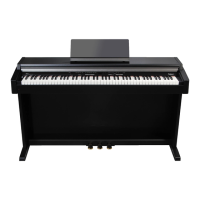
Do you have a question about the Roland MP-60 and is the answer not in the manual?
| Brand | Roland |
|---|---|
| Model | MP-60 |
| Category | Musical Instrument |
| Language | English |
Describes the realistic piano sound generation and polyphony.
Details the hammer action keyboard and pedal response for a grand piano feel.
Highlights features like metronome and two-track recorder for musical development.
Mentions the inclusion of classical pieces for listening and lessons.
Explains the meaning of WARNING and CAUTION labels used in the manual.
Clarifies the meaning of various symbols used to convey important information.
Lists essential precautions to observe when using the unit.
Details on connecting the power supply, potential interference, and complete disconnection.
Guidance on unit placement, avoiding temperature extremes, humidity, and dust.
Instructions on cleaning the unit and care for the pedals.
Advice on handling controls, connecting cables, and general operation.
Introduction to the 65 onboard piano songs.
How to play all internal songs in sequence.
Steps to choose and play individual internal songs.
Explains selecting and layering different tones using TONE SELECT buttons.
Describes how to layer two sounds simultaneously with a single key press.
How to adjust the volume mix between the two layered tones in Dual Play.
How to divide the keyboard and play different sounds in each area.
How to set the key that divides the keyboard into left and right sections.
Instructions on activating and using the built-in metronome.
Covers adjusting metronome volume, beat, and sound type.
How to add reverb and adjust its depth for richer sound.
How to shift the pitch of the keyboard to a different key.
Modifying the playing feel of the keyboard based on touch.
How to slow down or speed up the tempo of internal songs for practice.
Setting up a lead-in count before a song begins to ensure proper timing.
Practicing songs by isolating and playing either the left or right hand part.
Instructions for recording your own keyboard performance without accompaniment.
How to record your playing while listening to an internal song.
Recording the left and right hand parts onto separate tracks.
Procedures for deleting recorded songs or specific tracks.
Adjusting the level of sympathetic resonance for piano tones.
Accessing advanced settings like tuning, temperament, and MIDI configurations.
Adjusting the reference pitch to match other instruments.
Selecting different historical tuning systems for musical styles.
Applying a tuning curve that expands bass and treble ends for piano solos.
Enabling the damper pedal effect for the left-hand keyboard section in Split Play.
Disables all buttons except for grand piano play to prevent accidental changes.
Disables all buttons while maintaining current settings, useful for specific tones.
How to connect to audio systems for playback or recording.
Linking the MP-60 to a computer via USB MIDI for data transfer.
Interfacing with other MIDI instruments for performance control and data exchange.
Configuring MIDI transmit channels and other MIDI functions.
Setting the MIDI channel for transmitting performance data.
Managing the link between keyboard input and internal sound generator.
Sending recorded performance data to an external MIDI device or computer.
